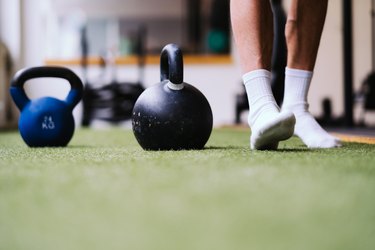
If you spend some time in the weight room at your gym, you may come across people deadlifting or squatting in their socks. And while it's possible some of them forgot their gym shoes at home, odds are, they're doing it on purpose.
Lifting weights barefoot or in socks get a bad reputation for having the potential to lead to injury, but if you do it correctly, going shoeless might just be the trick you need to increase your strength without any added risk.
Video of the Day
Video of the Day
Read more: How to Get Started With Weight Lifting
Benefits of Lifting in Your Socks
While shoes protect you from any debris on the gym floor, habitual use of footwear can influence the structure of your foot and potentially alter your foot position and mechanics, according to a September 2015 review published in Gait & Posture. In addition to combatting that effect, there are several key benefits to kicking your shoes off at the gym:
Increased Foot Strength
Even though you use your feet to get you through every exercise (handstand walks aside), the foot muscles don't get as much of the strengthening benefit as the rest of your body if you're wearing shoes.
"Your foot is packed with 20 muscles that help support standing, walking and other movements," says Tyler Nightingale, DPT, physical therapist at Bespoke Treatments in New York City. "A lot of times, wearing a shoe will decrease the activity of these muscles with no relevant upside other than shock absorption, which is important for some activities."
Opting to go shoe-less and weight lifting in your socks, can help increase the muscle activity in your feet, he says, giving those muscles some much-needed attention.
Improved Balance
Considering barefoot training can improve your foot muscle strength it can, in turn, also positively affect your balance, Nightingale says. That's especially important for older adults who are often at higher risk for fall-related injury, according to the Centers for Disease Control and Prevention.
Stronger Lifts
Lifting weights in socks or with bare feet can help you feel more grounded, enabling you to engage more muscles, Nightingale says. This can be especially helpful with compound lifts like deadlifts or squats, where the weight you're maneuvering is generally heavier.
The higher level of muscle engagement can improve the quality of your movements and lifts, Nightingale says. "Your brain gets better sensory feedback from the floor via your foot," he says. For those that have hit a weight plateau, this may be just the trick you need to add another 10 pounds to the barbell.
Read more: How to Stop Foot Pain With 7 Easy Exercises
Is Barefoot Training Safe for You?
Although barefoot training can help increase your strength and mind-body connection, there are some people who may want to avoid exercising in socks altogether, Nightingale says.
People with low bone mineral density (those with osteopenia or osteoporosis) should keep their shoes on while exercising. And anyone with a recent lower-limb fracture should also be very cautious when changing their footwear.
Don't forget to consider what type of exercise you're doing before neglecting your shoes completely, he says. If your workout consists of plyometric exercises, especially on a hard surface, you'll want to avoid taking off your shoes.
Similarly, proceed with caution if you frequently exercise outdoors. The last thing you want is a stray piece of glass or plastic leaving you injured. Or if you're training on the hardwood floors, you may want to remove your socks, too, to avoid slipping.
Read more: Is It OK to Exercise Barefoot?
How to Ease Into Barefoot Training
Before you dive into your first barefoot training session, it's important to educate yourself and take a few precautions. While there are some clear benefits to weight lifting in your socks, it's not a good idea to quit your current shoe cold turkey.
Nightingale recommends starting slowly to avoid potential injury. One great way is with barefoot lifting shoes. These are minimalist shoes that mimic the sensation of being barefoot. When you wear them, you're still able to grip the floor with your feet, but you give your feet some more protection from rough surfaces and crashing weights.
Transitioning to barefoot training is more about the time spent barefoot as opposed to the weight you lift, he says. In other words, no need to adjust the weight you're using while training barefoot.
Begin by devoting five minutes of your training session to barefoot training, Nightingale says. Then, add an additional five minutes to every training session each week until your entire strength-training program is occurring barefoot.
While this may seem like a really long process (especially if your training sessions are on the longer side), stay patient. "It's really important to give your feet enough time to adapt, even if it doesn't feel like you need it," he says.
Related Reading
Was this article helpful?
150 Characters Max
0/150
Thank you for sharing!
Thank you for your feedback!
Is this an emergency? If you are experiencing serious medical symptoms, please see the National Library of Medicine’s list of signs you need emergency medical attention or call 911.